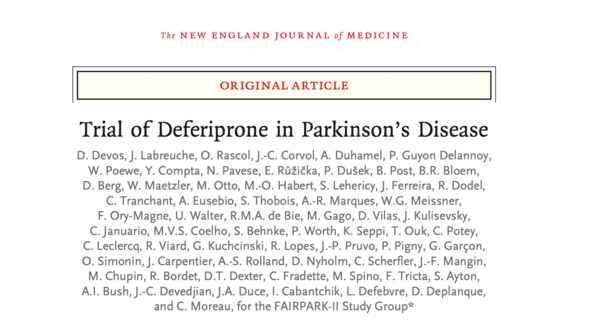Item 6 - Iron dyshomeostasis, ferroptosis, a new type of iron-related regulated cell death
Iron is intimately involved in the production and breakdown of dopamine. Our group and others have demonstrated in all experimental models of PD that reducing excess iron with treatments called iron chelators (“iron scavengers and scavengers”) limits neuronal death. We were the first in the world to demonstrate that a novel type of iron-related regulated cell death, called ferroptosis, was prevalent in the PD model.
Interestingly, ferroptosis can be extinguished by an iron chelator. Deferiprone is a medication that has the ability to remove iron from overloaded areas and has been used regularly for many years to treat iron overload in a rare red blood cell disease (called thalassemia).
Our previous studies in small groups of PD patients suggested that treatment with deferiprone in addition to usual dopamine replacement drugs not only reduced brain iron accumulation but also improved motor disability.
The multicenter and multinational FAIRPARK-II study published in the New England Journal of Medicine was therefore designed to study the neuroprotective potential of deferiprone. FAIRPARK-II (funded by the European Union Horizon 2020 grant, n° 633190, drug supplied by Apopharma/Chiesi; ClinicalTrials.gov number, NCT02655315) was promoted by Lille University Hospital, coordinated by Professor Devos.
It recruited 372 people from 23 centers in Europe to test whether deferiprone could slow disease progression when given shortly after diagnosis and before the start of symptomatic treatment with dopamine replacement drugs. . Patients were randomized to receive either oral deferiprone or an identical-appearing placebo for 9 months.
Analysis of the results of the FAIRPARK-II study showed that deferiprone induced a reduction of iron in brain centers important for the control of movements. However, surprisingly and contrary to the study hypothesis, treatment with deferiprone worsened the symptoms.
The results of FAIRPARK-II could indicate that the accumulation of iron in the brain could have a double effect in Parkinson's disease: on the one hand, at the beginning of the disease, iron may be necessary to support the increase in dopamine production, because dopamine levels decrease during the disease and iron is needed. for the production of dopamine. On the other hand, iron can become deleterious in the longer term, when its accumulation begins to contribute to neuronal death by ferroptosis.
Recently, we published two other studies SKY and Embark, which confirmed that the combination of L-dopa with deferiprone avoided any aggravating effects and that a lower dose of deferiprone (600 mg) was even closed. to significantly reduce the progression of the disease.
We were financed by two other European funds (Coen and Eurostar) to further develop this new therapeutic concept of conservative iron chelation with new molecules (SP420 from Pharmacosmos, ATH434 from Alterity, Cajal Neurosciences). Finally, promising preclinical results on ferroptosis trigger numerous research programs on antiferroptotic drug outcomes (e.g. PTC therapies with lox 15 inhibitor and our ACSL4 inhibitor program (ANR fund).


